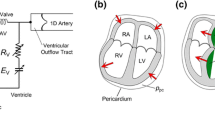Abstract
Current quantitative descriptions of the cardiovascular system in hemorrhagic shock focus on pressure based metrics. This approach is often incomplete; overlooking the important role of tissue perfusion. Electrical analogs to the cardiovascular system may offer a more complete description of hemorrhage. Application of fundamental concepts in electrical circuit theory (i.e.; Kirchhoff’s Voltage Law and Ohm’s Law) to analogs of the cardiovascular system offers a more refined description of this complex process. This manuscript hopes to serve as a starting point for a more mathematically robust, and clinically relevant description of hemorrhagic shock.

Similar content being viewed by others
References
Cecconi, M., N. Arulkumaran, J. Kilic, C. Ebm, and A. Rhodes. Update on hemodynamic monitoring and management in septic patients. Minerva Anestesiol. 80(6):701–711, 2014.
Chesnut, R. M., L. F. Marshall, M. R. Klauber, B. A. Blunt, N. Baldwin, H. M. Eisenberg, et al. The role of secondary brain injury in determining outcome from severe head injury. J. Trauma 34(2):216–222, 1993.
Cousins, W. G. P. Boundary conditions for hemodynamics: the structured tree revisited. J. Comput. Phys. 231:6086–6096, 2012.
Cowell, E. M. Nature and treatment of wound shock and allies conditions. JAMA 70(9):607–621, 1918.
Csete, M. E., and J. C. Doyle. Reverse engineering of biological complexity. Science 295(5560):1664–1669, 2002.
Dobson, G. P., and H. L. Letson. Adenosine, lidocaine, and Mg2+ (ALM): from cardiac surgery to combat casualty care–teaching old drugs new tricks. J. Trauma Acute Care Surg. 80(1):135–145, 2016.
Duanmu, Z., M. Yin, X. Fan, X. Yang, and X. Luo. A patient-specific lumped-parameter model of coronary circulation. Sci. Rep. 8(1):874, 2018.
Dutton, R. P., C. F. Mackenzie, and T. M. Scalea. Hypotensive resuscitation during active hemorrhage: impact on in-hospital mortality. J. Trauma 52(6):1141–1146, 2002.
Grodins, F. S. Integrative cardiovascular physiology: a mathematical synthesis of cardiac and blood vessel hemodynamics. Q. Rev. Biol. 34(2):93–116, 1959.
Guyton, A. C., T. G. Coleman, and H. J. Granger. Circulation: overall regulation. Annu. Rev. Physiol. 34:13–46, 1972.
How, R. A., J. J. Glaser, L. J. Schaub, D. M. Fryer, K. M. Ozuna, C. G. Morgan, et al. Prehospital adenosine, lidocaine, and magnesium has inferior survival compared with tactical combat casualty care resuscitation in a porcine model of prolonged hemorrhagic shock. J. Trauma Acute Care Surg. 87(1):68–75, 2019.
Huygh, J., Y. Peeters, J. Bernards, and M. L. Malbrain. Hemodynamic monitoring in the critically ill: an overview of current cardiac output monitoring methods. F1000Res 2016. https://doi.org/10.12688/f1000research.8991.1.
Kiran Kumar, Y., S. B. Mehta, and M. Ramachandra. Simulation study of hemodynamic in bifurcations for cerebral arteriovenous malformation using electrical analogy. J. Biomed. Phys. Eng. 7(2):143–154, 2017.
Letson, H. L., and G. P. Dobson. Correction of acute traumatic coagulopathy with small-volume 7.5% NaCl adenosine, lidocaine, and Mg2+ occurs within 5 minutes: a ROTEM analysis. J. Trauma Acute Care Surg. 78(4):773–783, 2015.
Letson, H., and G. Dobson. Adenosine, lidocaine and Mg2+ (ALM) fluid therapy attenuates systemic inflammation, platelet dysfunction and coagulopathy after non-compressible truncal hemorrhage. PLoS ONE 12(11):e0188144, 2017.
Letson, H. L., and G. P. Dobson. Adenosine, lidocaine, and Mg2+ (ALM) resuscitation fluid protects against experimental traumatic brain injury. J. Trauma Acute Care Surg. 84(6):908–916, 2018.
Marik, P. E. Obituary: pulmonary artery catheter 1970 to 2013. Ann. Intensive Care 3(1):38, 2013.
Naik, K. B. Mathematical modeling and simulation of human cardiovascular system. Surat: Veer Narmad South Gujarat University: Veer Narmad South Gujarat University, 2015.
Naik, K. B. P. Mathematical modeling of human cardiovascular system: a lumped parameter approach and simulation. Int. Sch. Sci. Res. Innov. 11(2):73–84, 2017.
Paradis, N. A., G. B. Martin, J. Rosenberg, E. P. Rivers, M. G. Goetting, T. J. Appleton, et al. The effect of standard- and high-dose epinephrine on coronary perfusion pressure during prolonged cardiopulmonary resuscitation. JAMA 265(9):1139–1144, 1991.
Ristagno, G., W. Tang, L. Huang, A. Fymat, Y. T. Chang, S. Sun, et al. Epinephrine reduces cerebral perfusion during cardiopulmonary resuscitation. Crit. Care Med. 37(4):1408–1415, 2009.
Sakka, S. G. Hemodynamic monitoring in the critically ill patient—current status and perspective. Front. Med. 2:44, 2015.
Tobin, J. M., R. P. Dutton, J. F. Pittet, and D. Sharma. Hypotensive resuscitation in a head-injured multi-trauma patient. J. Crit. Care 29(2):313, 2014.
Vodovotz, Y., M. Csete, J. Bartels, S. Chang, and G. An. Translational systems biology of inflammation. PLoS Comput. Biol. 4(4):e1000014, 2008.
Walsh, M., P. J. Devereaux, A. X. Garg, A. Kurz, A. Turan, R. N. Rodseth, et al. Relationship between intraoperative mean arterial pressure and clinical outcomes after noncardiac surgery: toward an empirical definition of hypotension. Anesthesiology 119(3):507–515, 2013.
Westerhof, N., F. Bosman, C. J. De Vries, and A. Noordergraaf. Analog studies of the human systemic arterial tree. J. Biomech. 2(2):121–143, 1969.
Funding
None.
Conflict of interest
All authors declare that they have no conflict of interest.
Author information
Authors and Affiliations
Corresponding author
Additional information
Associate Editor Ajit P. Yoganathan oversaw the review of this article.
Publisher's Note
Springer Nature remains neutral with regard to jurisdictional claims in published maps and institutional affiliations.
Rights and permissions
About this article
Cite this article
Tobin, J.M. Toward an Electrical Analog of the Cardiovascular System in Hemorrhage. Cardiovasc Eng Tech 12, 526–529 (2021). https://doi.org/10.1007/s13239-021-00545-8
Received:
Accepted:
Published:
Issue Date:
DOI: https://doi.org/10.1007/s13239-021-00545-8




